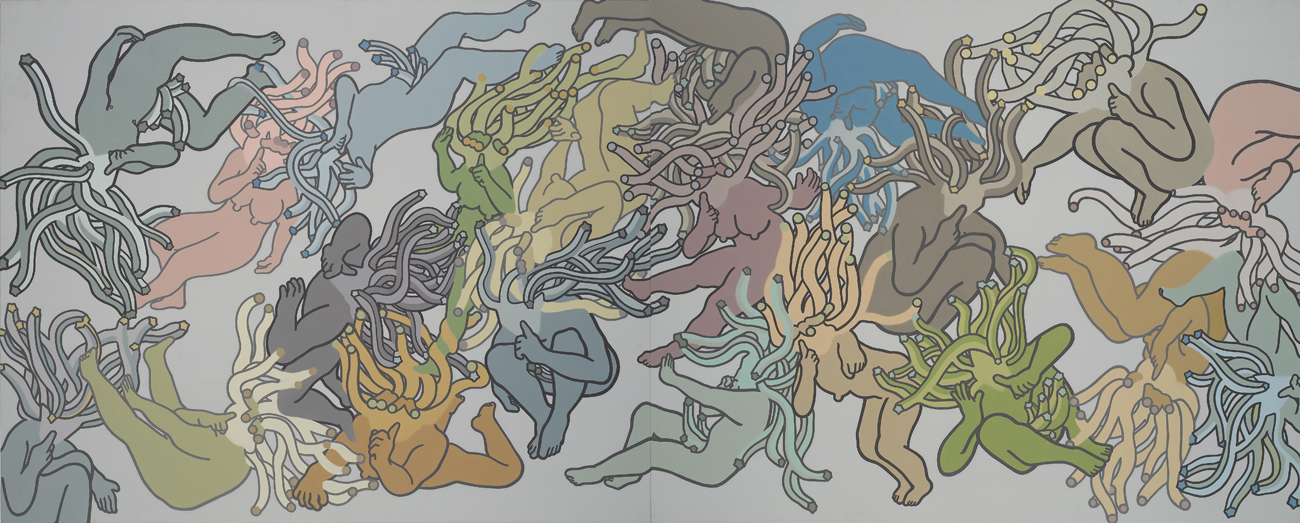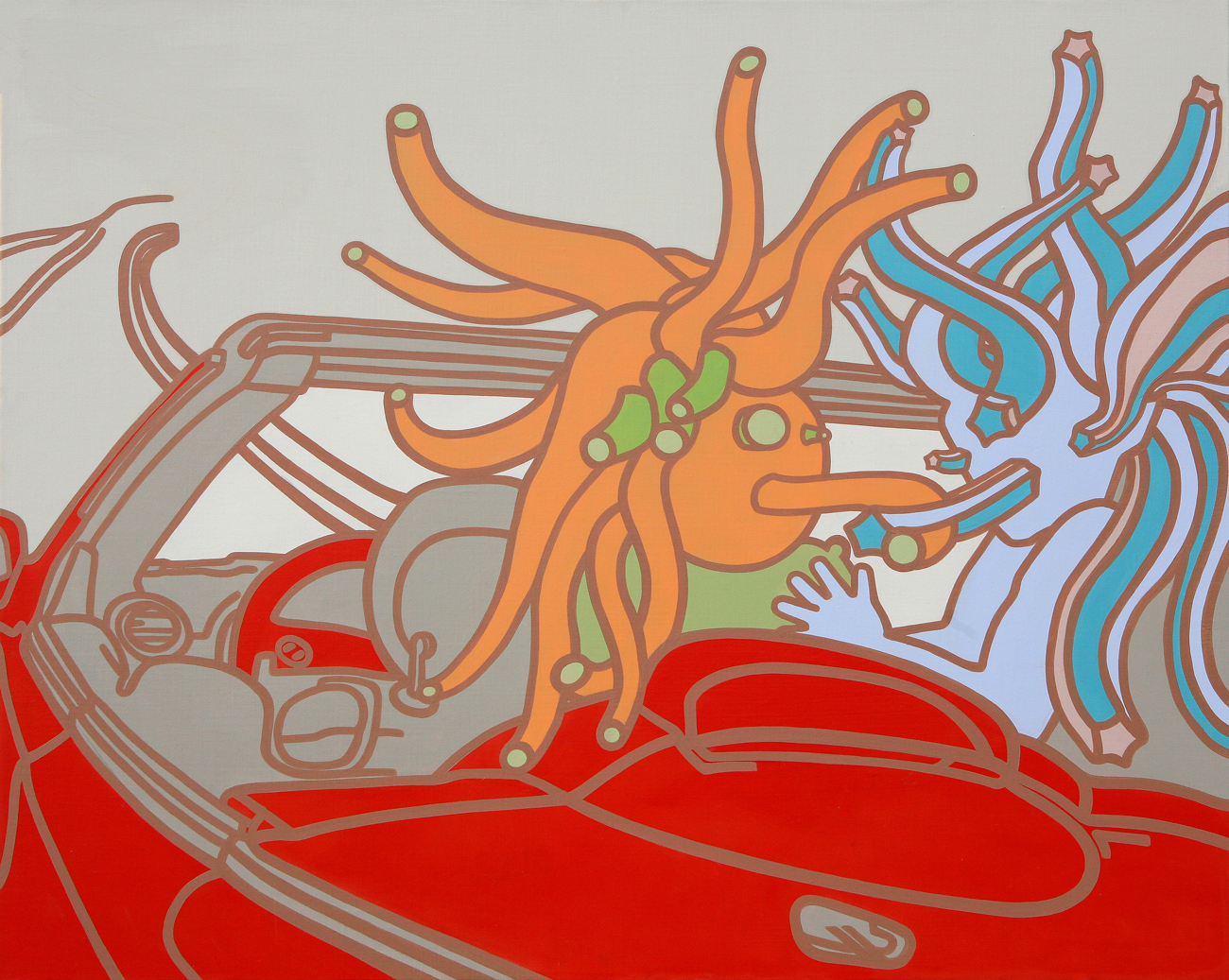
05 3월 Mato and Mayo – critic 2009

acrylic & oil on canvas 73 x 91 cm 2008
< Conversation needed! >
Mato & Mayo
The ‘relationship’ and ‘intercourse’ between Mayo and Mato
Nari Choi’s paintings consist of very simple colors and shapes, opening up a space of mutual communication between men and women, and one person and another. Choi’s works develop a story within the paintings’ spaces with the symbolic codes of a male and a female, which are created through images of mayonnaise and tomato ketchup tubes. In other words, the motif of Choi’s painting is composed of small stories about ‘differences’ and ‘relationships’ between men and women that she experiences or understands and by combining the experience of tastes and images found in everyday life.
As if the layers of sensation felt in everyday experience are divided into fine thicknesses, Choi’s work is symbolized by the characters ‘Mayo and Mato’, forming an organic space, and at the same time, reducing it to a planar surface with very clear lines and colors. The noteworthy points in the planar configuration scheme using colors and shapes are that firstly, ‘Mayo and Mato’ have become the main motifs of the painting in small stories, and secondly, the space with ‘Mayo and Mato’ that symbolize men and women. ‘Mayo and Mato’ form a one-to-one relationship or a group of men and women. Despite the neat configuration of colors and shapes, the surface projects a subtly dynamic image. Perhaps this is due to the concise composition, the various colors, and the way the space is constructed in harmony with the theme of the painting.
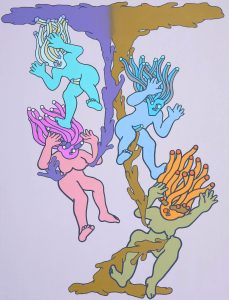
Slide of greed Acrylic & Oil on canvas 145.5 x 112cm 2008
With 100 to 200 works, Choi fills each with a composition of coordinated colors and lines on the smooth surface without allowing any gaps or any traces of brush strokes. For example: <Dance dance>, shown in this exhibition; <Camouflage>, which means ‘disguised’, show a ‘relationship’ with emotional bonds only with ‘Mayo and Mato’ without any background; <Slide of greed>, which shows the way one’s desire is revealed; while <Ssh ~!> portrays human society as a rich space. Nevertheless, in Choi’s paintings, I face emotions flowing through the gap between those lines and colors. This is because – as shown in the simplified composition of the characters ‘Mayo and Mato’ – Choi’s skill of coordinating the forces that occur between the changes of color and form, and dynamic movements shine in the abstraction of emotions.
acrylic & oil on canvas 130.3 x 324 cm 2008
<ssh~!>
Our lives within a family and society are composed of a man and a woman, and are in a complex network of other entities that are closely linked to the members of family and society; they are structurally and functionally integrated. In the works of Choi, she emphasizes only the relationships between men and women or between humans through very bright and clear colors, rather than the image of a human in a complex network. In short, Choi focuses on emotions that arise from the ‘intercourse’ of men and women or the ‘relationship’ between people while eliminating social background and environment.
Humans interact either directly or indirectly. In addition, humans have the strong effects on nature and urban ecosystems, and, at the same time, they are also influenced by the artificial environment created by themselves. Likewise, human survival grows and changes through the field of mutual communication with other individuals. In this way, the process of socialization will be on the basis of ability to control ourselves and to balance life on the premise of human inter-relationship. The relationship between human beings, the ability to self-control, and the balance of life shown in Choi’s paintings are in a relationship that is completely pure and devoid of any insincere or superficial surface.
Our present period has been achieved through the development of civilization for many years. The history and culture of humans have created our advanced technology through frequent trial and error, and they will continue to pursue a better life in the future. Additionally, as we become accustomed to civilization the pure and original sensitivity will gradually be lost. Perhaps it may be more important to find the sense of one’s body rather than focusing on rational judgements armed with all kinds of knowledge and information obtained from today’s advanced technology. In the busy city life, the confrontation with the pure human sense is for the sake of restoring our presence.
‘Mayo and Mato’ in Choi’s paintings are based on the premise of confrontation with the pure sense while taking off the burden that surrounds the life of modern people. Therefore, we confront the attributes of nature – which also communicates with our primitive senses – as we do with human nature. The body or nature that we encounter in Choi’s painting is a trail of everyday life in which the sensitivity of the artist explores the relationship of life and love. It is the relationship between you and I, and a space of communication between people. Modern human beings, projected on ‘Mayo and Mato’, are reflections on the relationship between creation and extinction: through the relationship between one body and another body, a part of a body, hair that spreads from a part of a body, and liquid that is released from a body. The resonance of colors and forms that portray such human ‘interjections’ or ‘relationships’ serves as a factor in achieving its own pictorial realization through a sense of primitive life and sensuous formality.
The works of Choi at the current exhibition – <Conversation>, where the place is specified; <You, who are too heavy for me>, an image of a man with uplifted arms as if lifting weights; <On the contrary, is contrary>, an image of ‘Mayo and Mato’ hanging upside down on a safety line – show a way of interpreting men and women as constructed through the perspective of the artist. Moreover, although there are differences between works, <a shameful Mayo>, <His & Her wavelength>, and <Rainbow heroine> reveal the personal experience reflected in ‘Mayo and Mato’, and the form of human nature and desire in diverse ways such as ‘intercourse’ and ‘relationship’ which develop from external objects. Furthermore, <Mato is a pants-soiler> embodies the desires of input and output by the use of cute characters while expanding the relationship between self and other.
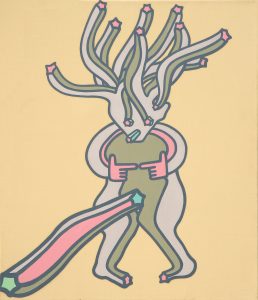
a shameful Mayo Acrylic & Oil on canvas 53 x 45.5cm 2008
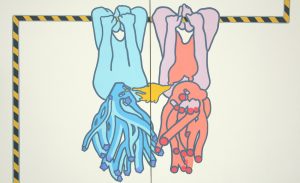
On the contrary, is contrary Acrylic & Oil on canvas 91 x 145.4cm 2008
Thus, the paintings of Choi reveal the basic human need to let viewers look at social desire regarding the relationship between themselves and others. With the use of characters, ‘Mayo and Mato’, the image of the relationship in which human desire is communicated is visualized by the smooth texture and the simple image that characterize modernity and the boundary of the social relation of an individual and a group. The boundaries of Choi’s perspective, the social relations of an individual and a group projected in ‘Mayo and Mato’, start from the setting of the self and proceed to the ‘relationship’ between humans through the emotional transaction that occurs between men and women. This is a new chapter in which the personal self or collective self communicates in the setting of the ‘relationship’ or the ‘intercourse’ where the artist encounters the psychological space of ‘Mayo and Mato’. For example, when the relationship between the self and the other in daily life penetrates into the artist’s sense, a new ‘relationship’ is created when a new visual relationship is formed. ‘Mayo and Mato’, which sweeps the painting space of Choi, is perhaps a link in our lives, a link between a man and a woman or a human and a human, self and other, virtual and real, etc. It may be a passage that strips away the strangeness of modern people. This passage is the place to relieve a sense of desire, which then becomes a place for aesthetic communication and a place where the lack of desire reveals the anxiety and loneliness embodied in the characters ‘Mayo and Mato’. Likewise, Choi’s paintings, which are reduced to vivid colors, lines and planar surfaces, eliminate vague boundaries and foster a sense of ‘intercourse’ or ‘relationship’ through concrete shapes that fill the deficiency of desire. Although such a deficiency was filled one day when the artist created the characters called ‘Mayo and Mato’ while eating mayonnaise and tomato ketchup, the extension of the deficiency growing in the hands and minds of the artist will create a new field of communication through various links, with individuals and groups communicating with a firmer vitality.
Although we are left with the task of making various attempts to move towards the ‘relationship’ or ‘intercourse’ of Choi’s ‘Mayo and Mato’, there is a great tendency to expand the field of communication across everyday life and its boundary. Above all, what I can expect is that the affectionate perspective of Choi does not rest on her reality, but she has a willingness to discover new fields of communication through insights on ‘relationships’ or ‘intercourse’.
Ok Ryeol kim (Art critic)
Mato & Mayo
마토와 마요가 만나는 ‘사이’ 혹은 ‘관계’
최나리의 그림은 매우 간결한 색과 형으로 남자와 여자 혹은 사람과 사람 사이에서 발생하는 상호소통의 장을 열어간다. 이렇게 열어놓은 소통의 장은 마요네즈와 토마토케첩튜브에서 연상된 이미지가 남성과 여성이라는 두 가지의 상징적인 코드로 그림속이야기를 전개해나가고 있다. 그래서 최나리의 회화적 모티브는 일상에서 발견한 미각체험과 시각적 이미지가 결합되어 자신이 경험하거나 이해하고 있는 남자와 여자의 ‘차이’와 ‘관계’를 작은 이야기들로 구성해내고 있다. 일상적 경험에서 느낀 감각의 층을 마치 미세한 두께로 잘라 놓은 듯, 최나리의 화면은 ‘마요와 마토’라는 캐릭터로 상징화되어 유기적인 공간을 구성하는 동시에 매우 선명한 선과 색을 통해 평면으로 환원시키고 있다.
색과 형으로 환원된 평면적 구성방식에서 주목되는 점은 ‘마요와 마토’는 작은 이야기에서 그림의 주된 모티브가 되고 있으며, 마요와 마토가 있는 자리는 최소한의 공간을 구성하는 배경과 오직 남자와 여자를 상징하는 캐릭터만으로 구성되어 있다는 점이다. ‘마요와 마토’는 일대일의 관계 혹은 다수의 남녀로 군상을 이루기도 하는데, 색과 형의 깔끔한 구성에도 불구하고 화면에는 미묘한 역동적인 이미지로 떠오른다. 아마도 이것은 간결한 구성과 다양한 색 그리고 공간을 구성하는 방식이 그림의 주제와 긴밀한 조화를 이루고 있기 때문일 것이다.
이를테면, 이번 전시에서 보여 지는 작품인 <Dance dance>, 위장 혹은 변장이라는 뜻을 가진 <Camouflage>는 배경이 없이 ‘마요와 마토’만으로 정서적인 유대를 가진 ‘관계’를 보여주고, 욕망이 드러나는 방식을 보여주는 듯한 <Slide of greed>, 공간을 부유하듯 인간군상을 이룬 <ssh~!> 등 100호에서 200호에 달하는 대작을 작가는 매끈한 화면에 조율된 색채의 구성으로 붓질의 흔적도 바탕이 드러나는 작은 틈도 허락하지 않고 화면을 선과 색으로 가득 채우고 있다. 그럼에도 이 작가의 그림에선 선과 색의 틈새를 뚫고 흐르는 감성과 마주하게 된다. 그것은 ‘마요와 마토’라는 캐릭터의 단순화된 구성방식에서 보여 지듯 감정의 절제 속에서도 색과 형의 변화와 다이나믹한 동작 사이에서 발생하는 힘들의 관계를 조율하는 솜씨가 빛을 발하기 때문이다.
우리의 삶은 가족과 사회 속에서 남자와 여자로 구성되어 있으며, 가족과 사회의 구성원으로 긴밀하게 연결되어 하나의 구조적이고 기능적인 통합을 이루는 실체로 복합적인 관계망 속에 놓여있다. 이렇게 복합적인 관계망 속에 놓인 인간의 모습을 최나리는 자신의 그림 속에서는 매우 밝고 선명한 색채를 통해 남자와 여자 혹은 인간과 인간의 관계만을 부각시켜 놓는다. 그래서 그의 그림에는 사회적인 배경이나 환경은 제거되고 남녀의 ‘사이’ 혹은 인간의 ‘관계’에서 발생하는 감성에 주목한다.
인간은 직간접적으로 상호작용을 한다. 뿐만이 아니라 인간은 자연이나 도시의 생태계 속에서 가장 강한 작용을 하는 동시에 스스로 조성해 놓은 인공적 환경으로부터도 다양한 영향관계에 있다. 이처럼 인간의 생존은 다양한 사람들과의 상호소통의 장을 통해 성장하고 또 변화해 간다. 이처럼 우리의 사회화 과정은 바로 인간과의 관계를 전제로 자기조절 능력과 삶의 균형을 이루어가는 것에 있을 것이다. 최나리의 그림에서 보여 지는 인간의 관계, 자기 조절능력, 삶의 균형을 이루는 방식은 그 어떤 가식적이거나 피상적인 외피에서 벗어나 온전히 맨몸으로 만나는 관계설정에 있다.
현대는 오랜 세월동안 문명의 발전을 거치며 이룬 것이다. 인간의 역사와 문화는 많은 시행착오를 통해 지금의 첨단기술을 이루었고, 앞으로도 보다 나은 생활을 추구하기위한 시도를 계속해 나갈 것이다. 그리고 문명의 이기에 길들여질수록 순수하고 원초적인 감각은 점점 상실되어 간다. 어쩌면 첨단 기술이 발달한 지금, 인간에게 절실하게 요구되는 것은 온갖 지식정보로 무장한 이성적인 판단보다는 내 몸의 감각을 찾는 일이 더 중요한 일인지도 모른다. 바쁜 도시생활 속에서 인간의 순수한 감각과의 대면은 존재감을 회복하는 일이기 때문이다.
최나리의 그림에 등장하는 ‘마요와 마토’는 현대인의 삶을 둘러싼 무거운 옷을 벗고 순수한 감각과의 대면을 전제한다. 그렇기에 최나리의 그림에선 인간의 속성과 만나듯, 인간의 원초적인 감각과 통하는 자연의 속성과도 만난다. 최나리의 그림에서 만나는 몸 혹은 자연은 생명과 사랑이라는 관계를 탐색하는 작가적 감각이 녹아있는 일상의 흔적이고, 너와 나 사이에서 발생하는 관계이자 사람과 사람이 만나는 소통의 자리다. ‘마요와 마토’에 투영된 최나리의 현대인은 몸과 몸의 관계, 몸과 몸 사이 혹은 몸의 일부에서 확산되거나 분출되는 머리카락과 몸에서 분비되는 액체를 통해 생성과 소멸의 관계로 구체화 되고 있다. 이 같은 인간의 ‘사이’ 혹은 ‘관계’를 형상화하는 색과 형의 울림은 원초적 생명감과 감각적인 조형성을 통해 그 자신만의 회화적 구현을 이루어가는 요소로 작용한다.
최나리의 이번 전시작을 보면, 장소가 구체화되어 있는 <conversation>, 마치 역기를 들듯 두 팔로 남자를 번쩍 들어 올리고 있는 <You, who is too heavy for me>과 안전선에 거꾸로 매달려 있는 ‘마요와 마토’의 <On the contrary, is contrary>는 남녀를 해석하는 방식이 작가적 시각을 통해 재구성되고 있음을 본다. 그리고 <a shameful Mayo >, <His & Her wavelength>, <Rainbow heroine>는 작품 간의 차이는 있지만, ‘마요와 마토’에 반영된 개인적 경험과 외적 대상에서 발생하는 ‘사이’의 ‘관계’ 등을 여러 가지 방식에서 인간본성과 욕망의 형태로 드러내 보여주고 있다. 또한, <Mato is pants-soiler>는 인풋(input)과 아웃풋(output)의 욕망을 귀여운 캐릭터에 담아 자아와 타자와의 관계로 확장해 간다. 이렇듯 최나리의 회화는 인간의 기본적인 욕구방식을 드러냄으로써 내가 놓여있는 자리에서 나와 너 ‘사이’ 혹은 ‘관계’에 대한 사회적 욕망을 들여다보게 한다. 최나리의 작품은 이처럼 ‘마요와 마토’를 통해 인간의 욕망이 소통되는 관계의 형상을 현대성의 특징인 매끈한 질감과 간결한 이미지로 개인과 집단의 사회적 관계에 대한 경계를 시각화하고 있다.
‘마요와 마토’에 투영된 작가의 시선, 개인과 집단의 사회적 관계에 대한 경계는 자아라는 상황설정에서 출발해서 남녀 ‘사이’ 에서 발생하는 정서적 출구를 통해 인간과 인간의 ‘관계’로 나아간다. 이렇게 작가가 바라보는 심리적인 공간이자 ‘마요와 마토’가 만나는 자리인 ‘사이’ 혹은 ‘관계’의 설정에는 개인적 자아 혹은 집단적인 자아가 소통하는 하나의 새로운 장이다. 이를테면 일상 속에서 만나는 자아와 타자와의 관계가 작가의 감각 속에 스며들어 새로운 시각적 관계가 형성되는 순간 자아와 타자는 새로운 ‘관계’가 된다.
최나리의 회화적 공간을 유영하는 ‘마요와 마토’는 어쩌면 우리들 삶에 놓인 관계들, 남자와 여자 혹은 인간과 인간, 자아와 타자, 가상과 실재 등등을 연결하는 하나의 고리이거나, 현대인이 겹겹이 걸치고 있는 무감각의 껍질을 벗기는 통로일 것이다. 이 통로는 어디서 오는지 알기 어려운 불안과 고독이 ‘마요와 마토’라는 캐릭터로 들어가 근원적인 욕망을 들추어냄으로써 비로소 욕망을 해소하는 자리로 이는 ‘마요와 마토’를 통해 만나는 하나의 미적 소통의 장이자 욕망의 결핍이 채워지는 장소가 된다.
이처럼, 선명한 색과 선 그리고 평면으로 환원된 최나리의 그림은 모호한 경계는 사라지고 구체적인 형상을 통해 ‘사이’ 혹은 ‘관계’에서 발생하는 감각을 일깨우며 욕망의 결핍을 채운다. 이 결핍이 채워지는 것은 어느 날 마요네즈와 토마토케첩을 먹다가 ‘마요와 마토’라는 캐릭터를 탄생시키는 순간 이루어졌지만, 작가의 손과 마음에서 자라는 이 결핍의 확장은 더 확고한 생명력으로 개인과 집단이 교차하면서 다양한 연결고리로 소통의 새로운 장을 만들어 갈 것이다.
최나리의 ‘마요와 마토’가 확장된 ‘사이’ 혹은 ‘관계’로 나아가기 위해서는 다양한 시도를 통해 풀어가야 할 숙제가 남겨져 있지만, 일상과 일상 너머의 경계를 가로지르며 소통의 장을 확장해 가려는 일련의 시도는 시사 하는바가 크다. 무엇보다 계속해서 기대를 할 수 있는 것은 애정 어린 작가적 시선이 자기 현실에만 안주해 있지 않고, ‘사이’ 혹은 ‘관계’에 대한 통찰로 소통의 장을 새롭게 발견해 나가고자 하는 의지가 담겨있기 때문이다.
김옥렬(미술평론가)






